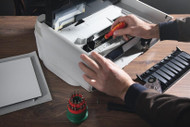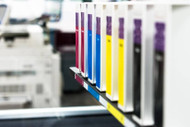The Impact of Temperature and Humanity on Ink Cartridge Performance
Temperature and humidity are environmental factors that can significantly affect the performance of ink cartridges. Ink, being a liquid substance, is sensitive to changes in temperature and humidity levels. Understanding the impact of these factors on ink cartridge performance is crucial for maintaining optimal print quality and prolonging the lifespan of your cartridges. Here's a closer look at how temperature and humidity can affect ink cartridge performance.
- Ink Consistency and Flow: Temperature variations can impact the consistency and flow of ink in cartridges. When the temperature is too low, ink may thicken and become sluggish, leading to poor ink flow. On the other hand, high temperatures can cause ink to thin out excessively, resulting in excessive bleeding and smudging. Maintaining an optimal temperature range, as recommended by the printer manufacturer, helps ensure that ink flows smoothly and consistently from the cartridge to the printhead, resulting in accurate and clean prints.
- Printhead Performance: Temperature and humidity can also affect the performance of the printhead, which is responsible for depositing ink onto the paper. Extreme temperatures can cause the printhead to expand or contract, leading to misalignment or inconsistent ink deposition. Additionally, high humidity levels can cause moisture buildup on the printhead, potentially leading to clogging or ink droplet distortion. It's important to keep the printing environment within the recommended temperature and humidity ranges to maintain optimal printhead performance.
- Ink Drying Time: Temperature and humidity levels can influence the drying time of printed documents. High humidity slows down the ink drying process, leading to longer wait times and increased risks of smudging or smearing. Conversely, low humidity can accelerate ink drying, potentially causing the ink to dry on the printhead or in the nozzles, leading to clogging issues. Maintaining a moderate humidity level helps ensure proper ink drying without compromising print quality.
- Ink Shelf Life: Ink cartridges have a limited shelf life, and temperature and humidity play a crucial role in preserving the ink's quality during storage. High temperatures can accelerate ink degradation and evaporation, reducing its lifespan and rendering it unusable. Similarly, high humidity levels can cause moisture to seep into the cartridges, affecting the ink's chemical composition. Proper storage of ink cartridges in a cool, dry environment helps extend their shelf life and ensures that the ink remains usable when needed.
- Printer Performance and Error Messages: Temperature and humidity fluctuations can impact the overall performance of your printer. Extreme temperatures or humidity levels outside the recommended range may trigger error messages or malfunctions in the printer's sensors or internal mechanisms. These errors can disrupt printing operations and affect the accuracy and quality of prints. Maintaining a controlled printing environment with stable temperature and humidity levels helps ensure smooth printer operation and minimizes the occurrence of errors.
Conclusion:
temperature and humidity have a significant impact on ink cartridge performance. They affect ink consistency and flow, printhead performance, ink drying time, ink shelf life, and overall printer performance. To maintain optimal print quality and prolong the lifespan of your ink cartridges, it's important to store them in a controlled environment with stable temperature and humidity levels. Following the recommended guidelines provided by the printer manufacturer helps ensure consistent and reliable performance, resulting in high-quality prints and efficient printer operation.





